A) an auctioneer helps set prices and arrange sales.
B) there are only a few sellers.
C) the forces of supply and demand do not apply.
D) no individual buyer or seller has any significant impact on the market price.
F) All of the above
Correct Answer

verified
Correct Answer
verified
Multiple Choice
If toast and butter are complements, then which of the following would increase the demand for toast?
A) a decrease in the price of toast
B) a decrease in the price of butter
C) an increase in the price of butter
D) Both a and b are correct.
F) A) and B)
Correct Answer

verified
Correct Answer
verified
Multiple Choice
Suppose there is a decrease in the price of corn. If corn is an input into the production of ethanol, we would expect the supply curve for ethanol to
A) shift rightward.
B) shift leftward.
C) become flatter.
D) remain unchanged.
F) B) and D)
Correct Answer

verified
Correct Answer
verified
Multiple Choice
Which of these statements does not apply to market economies?
A) Prices prevent decentralized decision making from degenerating into chaos.
B) Prices coordinate the actions of millions of people with varying abilities and desires.
C) Prices ensure that anyone who wants a product can get it.
D) Prices ensure that what needs to get done does in fact get done.
F) None of the above
Correct Answer

verified
Correct Answer
verified
Multiple Choice
Table 4-12
A country club usually only allows members to purchase tickets for its celebrity golf tournament, but the club is considering allowing non-members to purchase tickets this year. The demand and supply schedules are as follows:
 -Refer to Table 4-12. If both members and non-members are allowed to purchase tickets to this year's celebrity golf tournament, then what will be the equilibrium price?
-Refer to Table 4-12. If both members and non-members are allowed to purchase tickets to this year's celebrity golf tournament, then what will be the equilibrium price?
A) $10
B) $15
C) $20
D) $25
F) None of the above
Correct Answer

verified
Correct Answer
verified
True/False
Cocoa and marshmallows are complements, so a decrease in the price of cocoa will cause an increase in the demand for marshmallows.
B) False
Correct Answer

verified
Correct Answer
verified
Multiple Choice
In a market economy, supply and demand are important because they
A) play a critical role in the allocation of the economy's scarce resources.
B) determine how much of each good gets produced.
C) can be used to predict the impact on the economy of various events and policies.
D) All of the above are correct.
F) A) and D)
Correct Answer

verified
Correct Answer
verified
Multiple Choice
Most studies indicate that tobacco and marijuana tend to be
A) substitutes.
B) complements.
C) unrelated because one good is legal while the other one is illegal.
D) inferior goods.
F) None of the above
Correct Answer

verified
Correct Answer
verified
Multiple Choice
Figure 4-27
Panel (a) Panel (b)
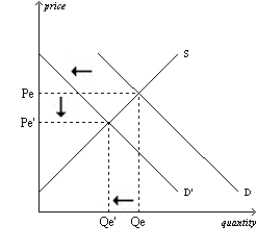
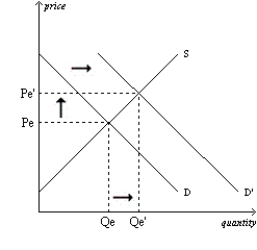 Panel (c) Panel (d)
Panel (c) Panel (d)
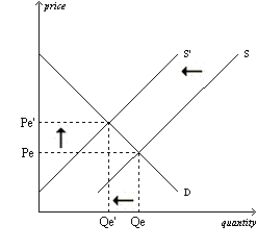
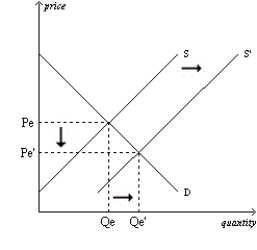 -Refer to Figure 4-27. Panel (b) shows which of the following?
-Refer to Figure 4-27. Panel (b) shows which of the following?
A) a decrease in demand and a decrease in quantity supplied
B) a decrease in demand and a decrease in supply
C) a decrease in quantity demanded and a decrease in quantity supplied
D) a decrease in quantity demanded and a decrease in supply
F) B) and C)
Correct Answer

verified
Correct Answer
verified
Short Answer
Scenario 4-1
Suppose the demand schedule in a market can be represented by the equation



 , where
, where  is the quantity demanded and is the price. Also, suppose the supply schedule can be represented by the equation , where is the quantity supplied.
-Refer to Scenario 4-1. What is the equilibrium price in this market?
is the quantity demanded and is the price. Also, suppose the supply schedule can be represented by the equation , where is the quantity supplied.
-Refer to Scenario 4-1. What is the equilibrium price in this market?
Correct Answer

verified
Correct Answer
verified
True/False
An increase in demand will cause an increase in price, which will cause an increase in quantity supplied.
B) False
Correct Answer

verified
Correct Answer
verified
Multiple Choice
In a competitive market, the quantity of a product produced and the price of the product are determined by
A) buyers.
B) sellers.
C) both buyers and sellers.
D) None of the above is correct.
F) A) and B)
Correct Answer

verified
Correct Answer
verified
Multiple Choice
What would happen to the equilibrium price and quantity of lattés if coffee shops began using a machine that reduced the amount of labor necessary to produce steamed milk, which is used to make lattés, and scientists discovered that lattés cause heart attacks?
A) Both the equilibrium price and quantity would increase.
B) Both the equilibrium price and quantity would decrease.
C) The equilibrium price would decrease, and the effect on equilibrium quantity would be ambiguous.
D) The equilibrium quantity would decrease, and the effect on equilibrium price would be ambiguous.
F) A) and D)
Correct Answer

verified
Correct Answer
verified
Multiple Choice
Figure 4-26 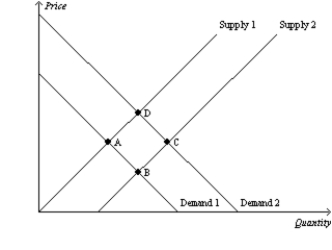 -Refer to Figure 4-26. Which of the following movements would illustrate the effect in the market for golf balls of an increase in green fees?
-Refer to Figure 4-26. Which of the following movements would illustrate the effect in the market for golf balls of an increase in green fees?
A) Point A to Point B
B) Point C to Point B
C) Point C to Point D
D) Point A to Point D
F) None of the above
Correct Answer

verified
Correct Answer
verified
Short Answer
Figure 4-28 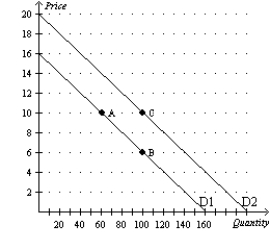 -Refer to Figure 4-28. Using the points on the figure, describe the change that would occur if the price of a substitute for this good becomes more expensive.
-Refer to Figure 4-28. Using the points on the figure, describe the change that would occur if the price of a substitute for this good becomes more expensive.
Correct Answer

verified
Correct Answer
verified
Multiple Choice
Figure 4-8 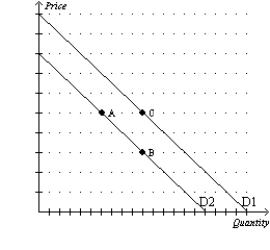 -Refer to Figure 4-8. Suppose the figure shows the market demand for Big Box e-readers. Suppose the price of the leading competitor's ereaders, a substitute good, decreases. Which of the following changes would occur?
-Refer to Figure 4-8. Suppose the figure shows the market demand for Big Box e-readers. Suppose the price of the leading competitor's ereaders, a substitute good, decreases. Which of the following changes would occur?
A) a movement along D2 from point A to point B
B) a movement along D2 from point B to point A
C) a shift from D1 to D2
D) a shift from D2 to D1
F) B) and D)
Correct Answer

verified
Correct Answer
verified
Multiple Choice
Figure 4-1 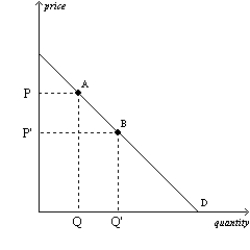 -Refer to Figure 4-1. The movement from point A to point B on the graph shows a(n)
-Refer to Figure 4-1. The movement from point A to point B on the graph shows a(n)
A) decrease in demand.
B) increase in demand.
C) decrease in quantity demanded.
D) increase in quantity demanded.
F) All of the above
Correct Answer

verified
Correct Answer
verified
Multiple Choice
Figure 4-17 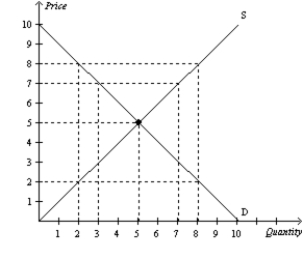 -Refer to Figure 4-17. At a price of
-Refer to Figure 4-17. At a price of
A) $2, there is a shortage of 6 units.
B) $5, there is a surplus of 25 units.
C) $5, there is a shortage of $25.
D) $7, there is a shortage of 4 units.
F) A) and B)
Correct Answer

verified
Correct Answer
verified
Multiple Choice
A improvement in production technology will shift the
A) supply curve to the right.
B) supply curve to the left.
C) demand curve to the right.
D) demand curve to the left.
F) B) and C)
Correct Answer

verified
Correct Answer
verified
Multiple Choice
"Other things equal, when the price of a good rises, the quantity demanded of the good falls, and when the price falls, the quantity demanded rises." This relationship between price and quantity demanded
A) applies to most goods in the economy.
B) is represented by a downward-sloping demand curve.
C) is referred to as the law of demand.
D) All of the above are correct.
F) A) and D)
Correct Answer

verified
Correct Answer
verified
Showing 481 - 500 of 698
Related Exams